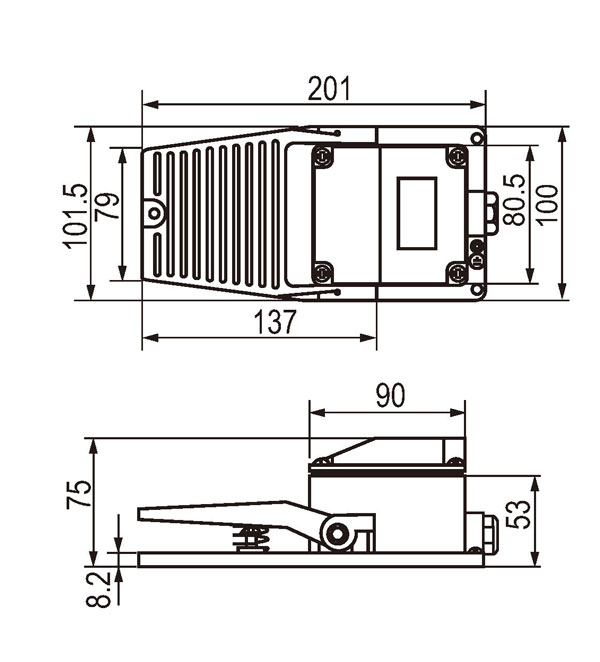
The SFM-1 aluminum housing foot switch is a durable and reliable industrial switch designed for various applications. Here's an overview of its main features and functions:
1. Construction: Made with an aluminum alloy die-cast for strength and durability .
2. Operation: It features a momentary action, which means the switch activates only when pressure is applied .
3. Contact Configuration: The switch typically has a 1c contact configuration with a Z-shaped micro switch built-in .
4. Protection Level: The SFM-1 has a protective structure rated at IP50, safeguarding against dust and water jets from any angle .
5. Voltage and Current Ratings: It is rated for AC250V and can handle up to 10A .
6. Design: The foot switch is designed to be operated even with safety boots, and it includes a stopper to prevent excessive force on the internal switch .
7. Applications: Ideal for use in machinery and electrical control where a sturdy and reliable foot switch is required .
For specific details, it's best to refer to the user manual or technical specifications provided by the manufacturer.
| Material | Aluminum Alloy Die-Cast |
| Motion | Momentary |
| Waterproof Function | Yes |
| Style | Pedal type |
| Rated | AC250V/10A |
| Contact Configuration | 1c |
| Color | Blue |
| Brand | Winston |

Proper maintenance and care of foot switches are essential for ensuring their long-term stability and safety. Here are some basic maintenance and care tips:
1. Regular Inspection: Periodically check if the wiring connections of the foot switch are secure and free from damage or breakage.
2. Clean the Surface: Wipe the surface with a soft cloth or cotton swab dipped in a small amount of cleaner, avoiding excessive moisture or strong corrosive cleaners that could damage the foot switch.
3. Water and Moisture Protection: Although foot switches typically have some water-resistant design, it is still necessary to pay attention to water protection during use. You can place desiccants or moisture-proof boxes around the foot switch to reduce the risk of moisture entering the switch internals.
4. Avoid Excessive Treading: When using the foot switch, avoid heavy or repeated treading to maintain a stable force and frequency, reducing wear and tear on the internal parts of the foot switch.
5. Regular Replacement and Upgrade: If a component of the foot switch is found to be damaged or malfunctioning, contact the equipment manufacturer or a professional repair person for replacement in a timely manner.
6. Check Switch Sensitivity: Ensure that the switch outputs the correct electrical signal when activated. If there is an abnormal output from the switch, further maintenance or replacement may be required.
7. Follow Operating Procedures: Medical staff should strictly follow operating procedures when using medical foot switches to avoid misoperation or improper use that could lead to equipment failure or accidents.
8. Check for Wear: Inspect easily worn parts of the foot switch, such as internal springs and contact points, and replace them when necessary.
9. Check Protection Level: Ensure that the protection level of the foot switch meets the requirements of the usage environment, such as dust and water resistance ratings.
10. Storage Conditions: If the foot switch needs to be stored for a long time, it should be placed in a dry, clean environment free from chemical corrosion.
These maintenance and care measures help extend the service life of the foot switch and ensure its safety and reliability during use.
GET A QUOTE